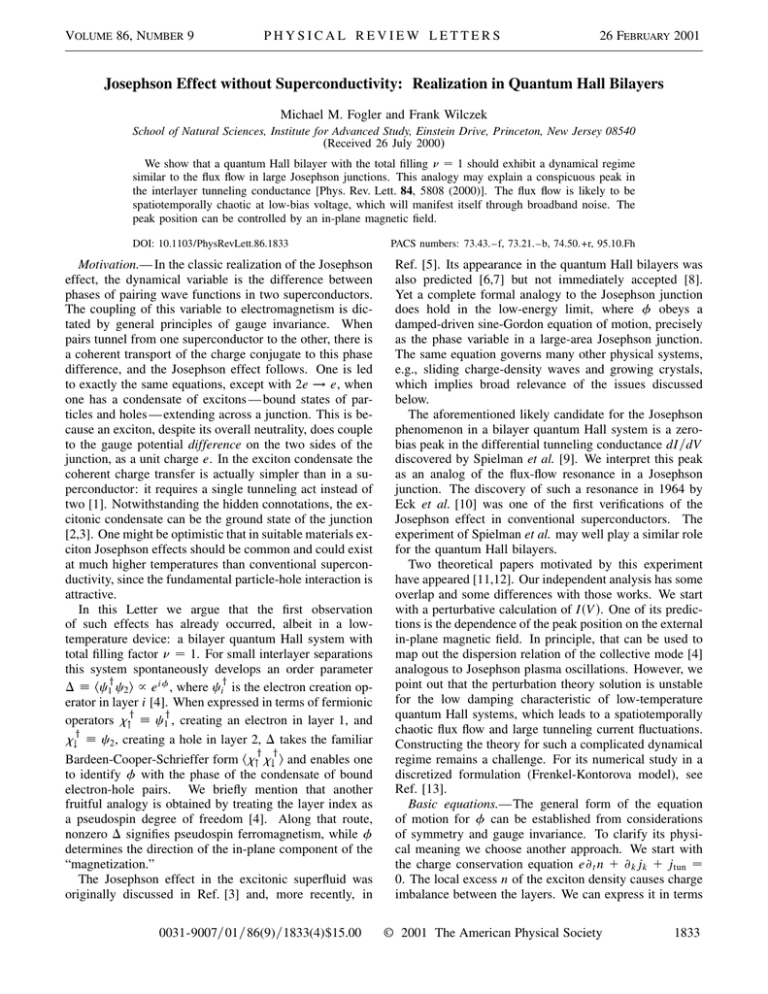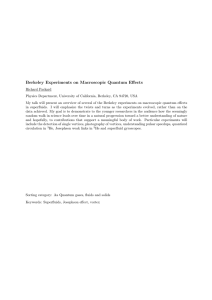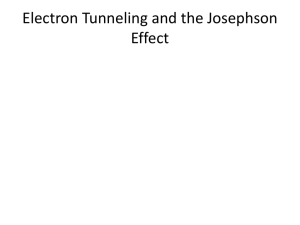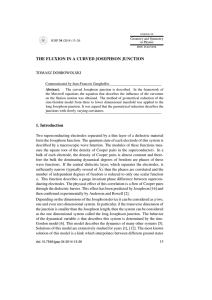Josephson Effect without Superconductivity: Realization in Quantum Hall Bilayers V 86, N 9
advertisement

VOLUME 86, NUMBER 9 PHYSICAL REVIEW LETTERS 26 FEBRUARY 2001 Josephson Effect without Superconductivity: Realization in Quantum Hall Bilayers Michael M. Fogler and Frank Wilczek School of Natural Sciences, Institute for Advanced Study, Einstein Drive, Princeton, New Jersey 08540 (Received 26 July 2000) We show that a quantum Hall bilayer with the total filling n 苷 1 should exhibit a dynamical regime similar to the flux flow in large Josephson junctions. This analogy may explain a conspicuous peak in the interlayer tunneling conductance [Phys. Rev. Lett. 84, 5808 (2000)]. The flux flow is likely to be spatiotemporally chaotic at low-bias voltage, which will manifest itself through broadband noise. The peak position can be controlled by an in-plane magnetic field. DOI: 10.1103/PhysRevLett.86.1833 Motivation.— In the classic realization of the Josephson effect, the dynamical variable is the difference between phases of pairing wave functions in two superconductors. The coupling of this variable to electromagnetism is dictated by general principles of gauge invariance. When pairs tunnel from one superconductor to the other, there is a coherent transport of the charge conjugate to this phase difference, and the Josephson effect follows. One is led to exactly the same equations, except with 2e ! e, when one has a condensate of excitons — bound states of particles and holes — extending across a junction. This is because an exciton, despite its overall neutrality, does couple to the gauge potential difference on the two sides of the junction, as a unit charge e. In the exciton condensate the coherent charge transfer is actually simpler than in a superconductor: it requires a single tunneling act instead of two [1]. Notwithstanding the hidden connotations, the excitonic condensate can be the ground state of the junction [2,3]. One might be optimistic that in suitable materials exciton Josephson effects should be common and could exist at much higher temperatures than conventional superconductivity, since the fundamental particle-hole interaction is attractive. In this Letter we argue that the first observation of such effects has already occurred, albeit in a lowtemperature device: a bilayer quantum Hall system with total filling factor n 苷 1. For small interlayer separations this system spontaneously develops an order parameter y y D ⬅ 具c1 c2 典 ~ eif , where ci is the electron creation operator in layer i [4]. When expressed in terms of fermionic y y operators x" ⬅ c1 , creating an electron in layer 1, and y x# ⬅ c2 , creating a hole in layer 2, D takes the familiar y y Bardeen-Cooper-Schrieffer form 具x" x# 典 and enables one to identify f with the phase of the condensate of bound electron-hole pairs. We briefly mention that another fruitful analogy is obtained by treating the layer index as a pseudospin degree of freedom [4]. Along that route, nonzero D signifies pseudospin ferromagnetism, while f determines the direction of the in-plane component of the “magnetization.” The Josephson effect in the excitonic superfluid was originally discussed in Ref. [3] and, more recently, in 0031-9007兾01兾86(9)兾1833(4)$15.00 PACS numbers: 73.43.–f, 73.21.– b, 74.50.+r, 95.10.Fh Ref. [5]. Its appearance in the quantum Hall bilayers was also predicted [6,7] but not immediately accepted [8]. Yet a complete formal analogy to the Josephson junction does hold in the low-energy limit, where f obeys a damped-driven sine-Gordon equation of motion, precisely as the phase variable in a large-area Josephson junction. The same equation governs many other physical systems, e.g., sliding charge-density waves and growing crystals, which implies broad relevance of the issues discussed below. The aforementioned likely candidate for the Josephson phenomenon in a bilayer quantum Hall system is a zerobias peak in the differential tunneling conductance dI兾dV discovered by Spielman et al. [9]. We interpret this peak as an analog of the flux-flow resonance in a Josephson junction. The discovery of such a resonance in 1964 by Eck et al. [10] was one of the first verifications of the Josephson effect in conventional superconductors. The experiment of Spielman et al. may well play a similar role for the quantum Hall bilayers. Two theoretical papers motivated by this experiment have appeared [11,12]. Our independent analysis has some overlap and some differences with those works. We start with a perturbative calculation of I共V 兲. One of its predictions is the dependence of the peak position on the external in-plane magnetic field. In principle, that can be used to map out the dispersion relation of the collective mode [4] analogous to Josephson plasma oscillations. However, we point out that the perturbation theory solution is unstable for the low damping characteristic of low-temperature quantum Hall systems, which leads to a spatiotemporally chaotic flux flow and large tunneling current fluctuations. Constructing the theory for such a complicated dynamical regime remains a challenge. For its numerical study in a discretized formulation (Frenkel-Kontorova model), see Ref. [13]. Basic equations.—The general form of the equation of motion for f can be established from considerations of symmetry and gauge invariance. To clarify its physical meaning we choose another approach. We start with the charge conservation equation e≠t n 1 ≠k jk 1 jtun 苷 0. The local excess n of the exciton density causes charge imbalance between the layers. We can express it in terms © 2001 The American Physical Society 1833 VOLUME 86, NUMBER 9 PHYSICAL REVIEW LETTERS of the local chemical potential difference m and the capacitance c per unit area: n 苷 cm兾e2 . The Josephson relation entails ≠t m 苷 h̄≠t2 f. The in-plane exciton current j consists of the supercurrent js 苷 共ers 兾h̄兲≠x f and the converted quasiparticle current jqp 苷 2≠x m兾erxx , where rs is the condensate phase stiffness and rxx is the resistivity of uncondensed quasiparticles. The Josephson tunneling current is jtun 苷 共e兾h̄兲n0 DSAS sin共f 2 Qx1 兲, where n0 is the average electron density per layer, DSAS is the tunneling strength, and Q 苷 eBd兾h̄c is the wave vector imposed by the in-plane component B of the external magnetic field along the x2 axis. (Its presence is necessitated by gauge invariance.) d is the interlayer separation. Assembling all the terms, we obtain the equation for f (cf. Ref. [4]): 共≠t2 2 b≠t ≠2x 2 ≠2x 兲f 1 sin共f 1 f0 2 Qx1 兲 苷 0 . (1) Here we expressed distances in units of “Josephson penetration length” lJ 苷 共rs 兾n0 DSAS 兲1兾2 and frequencies in units of “Josephson plasma frequency” vJ 苷 y兾lJ . The velocity parameter y 苷 共e兾h̄兲 共rs 兾c兲1兾2 ⬃ 0.1e2 兾k h̄ is the one that enters the dispersion relation [4,6] v 2 共q兲 苷 vJ2 1 y 2 q2 of the plasmon, and parameter b 苷 共1兾4p兲 共h̄vJ 兾rs 兲 共rxx e2 兾h兲 controls dissipation [14]. Finally, we included a random phase shift f0 to represent disorder (see below). By using the data reported in Ref. [9] and theoretical results reviewed in Ref. [4], we arrived at rough estimates lJ ⬃ 5 mm, vJ ⬃ 1010 s21 , and b ⬃ 0.01. Boundary conditions for Eq. (1) depend on the sample and measurement geometry. We consider the case where each layer is a square with side L, the contact to layer 1 is along the side x1 苷 2L兾2, 2L兾2 , x2 , L兾2, and the contact to layer 2 is along the side x1 苷 L兾2. This deviates somewhat from the setup used in Ref. [9] but should be inconsequential as long as the bottleneck for the current flow is the interlayer tunneling not the sheet conductivity. This is indeed the case experimentally because the inequality V ¿ Irxx is satisfied (V is the voltage difference between the contacts). Under such conditions it is also permissible to choose fL 苷 fR 苷 Vt, and use Z (2) I共t兲 苷 dx2 关≠1 fR 共t兲 2 ≠1 fL 共t兲兴 . to calculate the tunneling current. Here fL,R ⬅ f共x1 苷 6L兾2, x2 兲 and our units of voltage and electric current are V0 苷 h̄vJ 兾e and I0 苷 ers 兾h̄, respectively. Before we proceed to the calculations let us explain the origin of the term “flux flow.” Let us consider the case f0 苷 ≠t f 苷 V 苷 0 and focus on the limit Q ¿ 1, where the stable (ground-state) solution of Eq. (1) corresponds to an almost uniform phase distribution j≠1 fj ø 1. There is an equivalent alternative formulation in terms of a shifted phase u ⬅ f 2 Qx1 in which Q disappears from the argument of the sine but reemerges in the boundary conditions for ≠1 u 苷 ≠1 f 2 Q. In this formulation the ground 1834 26 FEBRUARY 2001 state u varies rapidly and almost linearly in space, which can be described as the 2p兾Q-periodic lattice of 2p solitons. A nonequilibrium state for V fi 0, where the phase increases uniformly with the rate V , can then be visualized as a uniform sliding of the soliton lattice —hence the term flux flow. Perturbation theory.— The perturbative solution of Eq. (1) for f0 苷 0 is readily done in terms of the Green’s function G共v, k兲 苷 关v 2 1 ia共k兲v 2 k 2 兴21 , a共k兲 ⬅ bk 2 . (3) The dc current Ī is then obtained by averaging Eq. (2) over time. The full expression is somewhat cumbersome but for L in the range 1 ø L ø Ī 21 it reduces to [10] a共Q兲V L2 Ī 苷 . (4) 2 2 共V 2 Q 2 兲2 1 a 2 共Q兲V 2 We estimate L ⬃ 50 and Ī ⬃ 1026 for the conditions of Ref. [9], so L is in the required range. From Eq. (4) we see that the resonance arises when the velocity V 兾Q of the soliton train matches the plasmon velocity y (y 苷 1 in the adopted dimensionless units). Under this condition the power dissipation in the system reaches a maximum. More generally, the resonance condition is eV 苷 h̄v0 共Q兲, where v0 共Q兲 is the DSAS ! 0 limit of the plasmon dispersion relation (in which the plasmon becomes the Goldstone mode). The last conclusion was reached independently in Refs. [11] and [12]. Let us turn to the disordered case, f0 fi 0. From Eq. (1) and the identity sinz 苷 Imeiz , one can see that the random phase factor eif0 plays the same role for the disordered system as the periodic phase factor eiQx1 for the clean system. The Fourier expansion of eif0 can be thought of as a set of “diffraction gratings” with different wave vectors k, resonating whenever V 苷 k. As a result, the resonance is broadened in proportion to the breadth of the Fourier spectrum of the following correlator: s共x兲 苷 具e2if0 共x兲 eif0 共0兲 典 , (5) and the appropriate generalization of Eq. (4) is Z d2k L2 s̃共k 2 Q兲G共V , k兲 . (6) Ī 苷 2 Im 2 共2p兲2 To evaluate the integral we assume that the random phase field f0 is mainly due to static randomly positioned and randomly oriented bound vortex pairs in the exciton condensate. In the context of the pseudospin ferromagnet analogy mentioned earlier [4], such vortices were recognized as merons, the topological defects of the O共3兲 nonlinear s model, and a remarkable fact was established: each meron possesses an overall electric charge e兾2 concentrated near its core. The competition of the Coulomb repulsion between the like electric charges and attraction between oppositely charged vortices selects the optimal size a of meron pairs; a remains finite below the roughening transition [15] temperature Tr 苷 8prs 兾kB . From our VOLUME 86, NUMBER 9 PHYSICAL REVIEW LETTERS point of view, in the context of the Josephson junction analogy, the meron pairs correspond to misaligned Abrikosov vortices trapped in the junction. The I-V characteristic of such junctions was investigated by Fistul and Giuliani [16]. These authors also attempted to go beyond the perturbation theory but that part of their calculation is suspect for reasons that will become clear shortly. Within the chosen model of disorder, we obtain s̃共k兲 苷 Aa2 共ka兲g22 , g ⬅ pnm a2 , A ⯝ 2pg, g ø 1, A ⯝ 2p ln共ka兲 21 , g 苷 2, (7) (8) (9) where nm is the average density of the meron pairs. Substituting the above formulas into Eq. (6) yields, for Q 苷 0 and Vⴱ ø V ø b 21 , Ī 苷 Iⴱ 共Vⴱ 兾V 兲22g , Iⴱ 苷 L2 a共Vⴱ 兲Vⴱ . (10) is determined from the Here Vⴱ 苷 关A共Vⴱ 兲a 兾8b兴 condition that the variance of f, which is given by 1 Z d2k 具f 2 典 苷 s̃共k 2 Q兲 jG共V , k兲j2 , (11) 2 共2p兲2 g 1兾共52g兲 becomes of the order of 1. At V , Vⴱ the premise of the perturbation theory 共f ø 1兲 is violated and formula (10) is invalid. However, V 苷 Vⴱ is not the true boundary of the perturbative domain. Below we will show that the perturbation theory actually breaks down in a wider range of voltages, V , Vⴱⴱ , where Vⴱⴱ ¿ Vⴱ for small b. In the following we focus on the case g 艐 2 (not an unreasonable value [17]), where the Fourier spectrum of eif0 is extremely broad [see Eq. (7)]. The flux-flow resonance is equally broad so that it shows up as a plateau in Ī共V 兲 (see Fig. 1). With the chosen value of g we get the expression (physical units temporarily restored) Iⴱ ⬃ 共ers 兾h̄兲 共L2 a2 兾lJ4 兲 (12) for the height of the plateau. Similar expressions were also derived in Refs. [11] and [12]. Even though the response at low V is beyond the reach of the perturbation theory, the “Josephson critical current,” which is a zero-bias parameter, can nevertheless be calculated. The collective-pinning theory of Vinokur and FIG. 1. I-V characteristic given by the perturbation theory with g 艐 2 (solid line). The dashed line is a conjecture. 26 FEBRUARY 2001 Koshelev [18] yields (for g 苷 2) Ic 苷 2共ers 兾h̄兲 共L2 a2 兾l4J 兲 ln2 共lJ 兾a兲 . (13) Reminiscent of the inequality between the coefficients of static and kinetic friction, Ic exceeds Iⴱ . Note that Ic is essentially a static quantity. It need not coincide with the V ! 0 limit of the dynamical response formulas similar to Eq. (6). The overall dependence of Ī on V is likely to appear the way it is shown in Fig. 1. Choosing g 艐 2 enables us to reproduce the plateau feature in the experimental data [9] (the peak in dI兾dV corresponds to a plateau in Ī vs V ), but the theoretical estimate of Iⴱ is off by 2 orders of magnitude. However, this estimate is highly unreliable in view of large uncertainties in the parameters of the model and of their strong renormalization by thermal fluctuations, known from the theory of the roughening transition [15]. Instability of a tachyonic flux flow.— It is known, although not widely appreciated, that the perturbation theory solution for the case f0 苷 0— in the form of a moving soliton lattice — can become unstable when the lattice velocity exceeds the velocity of Josephson plasmon, V 兾Q . 1. The instability can be understood as a parametric resonance driven by the external source of frequency V and wave vector Q. Indeed, if V . Q, then kinematics allows a simultaneous excitation of two counterpropagating plasma waves, with wave vectors k6 苷 共Q 6 V 兲兾2. For large Q the instability appears when (cf. Ref. [19]) G 21 共k1 , k1 兲G 21 共2k2 , k2 兲 , 1兾4, V . Q , (14) and so the perturbation theory solution on the “tachyonic” side V . Q is stable only if V . Vⴱⴱ 苷 共4兾b兲1兾3 (Q ø Vⴱⴱ is assumed). This condition is much more restrictive than the naive V 2 Q ¿ Q 21 derived from the criterion jfj ø 1. Very close to the threshold Vⴱⴱ , the parametric resonance described above produces a small modulation of the uniform soliton train [19], but as V moves closer to Q other unstable modes proliferate and the system dynamics quickly enters the regime of spatiotemporal chaos. In Fig. 2 we show the comparison between the results of the naive perturbation theory and our numerical simulations of a one-dimensional system. As expected, they agree when either V * Vⴱⴱ or Q 2 V * Q 21 , but at intermediate V ’s they differ substantially and a strong broadband noise in I sets in. Let us now show that a similar instability must occur in the disordered case as well. To estimate the corresponding Vⴱⴱ , we approximate the unstable modes by wave packets of plasma waves with a Gaussian spread of wave vectors, c6 共k兲 苷 共2pDk 2 兲21 exp关2jk 2 k6 j2 兾2共Dk兲2 兴. If Dk is smaller than a共k6 兲, then G共k, k兲 is approximately the same for dominant k’s within the wave packets, and so the left-hand side of the instability criterion (14) need not be modified. The right-hand side, however, is changed from 1835 VOLUME 86, NUMBER 9 PHYSICAL REVIEW LETTERS dc current ........................ . . ..... . .. .. .............. .... 2 4 6 Voltage 8 0 2 4 8 6 10 FIG. 2. Top: I-V characteristic. Dots are from numerics, and the solid line is from a full perturbation theory formula for a finite-length system. It contains both the main resonance of Eq. (4) and smaller “Fiske resonances.” The scatter of the data points at V . 2.5 is due to statistical noise. The parameters of simulation are L 苷 20, Q 苷 3, b 苷 0.01, and f0 苷 0. Bottom: an example of the frequency spectrum of I共t兲 in the above simulation. Note the narrow peak at v equal to the applied voltage V 苷 4 and the strong broadband noise at smaller v’s. 1兾4 to 共1兾2p兲s̃共V 2 Q兲 共Dk兲2 and the threshold voltage becomes Vⴱⴱ ⬃ b 21兾2 s̃ 21兾8 . Thus, for small b the lowest voltage at which the perturbation theory is expected to apply is Vⴱⴱ ¿ Vⴱ . Our conjecture on the behavior of Ī in the interval Vⴱ , V , Vⴱⴱ (depicted in Fig. 1) is based on a notion that chaos leads to a higher effective dissipation [see Fig. 2 (top) and Refs. [13] and [19] ]. The suppression of Ī below Vⴱ is an educated guess motivated by the work of Fistul and Giuliani [16]. The probable observation of Josephson effects without bulk superconductivity in a bilayer quantum Hall ferromagnet paves the way for exploring a vast variety of other Josephson phenomena in this system. It should also inspire attempts to realize them in other systems. The complexity and appeal of the emerging theoretical issues (not fully appreciated in the current literature), as well as their re- 1836 currence in other contexts warrant further study. From this perspective the lack of quantitative agreement between the perturbation theory and experiment is stimulating. M. M. F. is indebted to Jim Eisenstein for illuminating discussions and to the Aspen Center for Physics for hospitality. This research is supported by US DOE Grant No. DE-FG02-90ER40542. 10 |I | 0 26 FEBRUARY 2001 [1] For direct excitons (with zero quasimomentum). [2] Yu. E. Lozovik and V. I. Yudson, Sov. Phys. JETP 44, 389 (1976). [3] S. I. Shevchenko, Sov. J. Low Temp. Phys. 2, 251 (1976). [4] For a review, see S. M. Girvin and A. H. MacDonald, in Perspectives in Quantum Hall Effect, edited by S. Das Sarma and A. Pinczuk (Wiley, New York, 1997), Chap. IV; J. P. Eisenstein, ibid., Chap. III. [5] Yu. E. Lozovik and A. V. Poushnov, Phys. Lett. A 228, 399 (1997). [6] X. G. Wen and A. Zee, Phys. Rev. Lett. 69, 1811 (1992); Phys. Rev. B 47, 2265 (1993). [7] Z. F. Ezawa and A. Iwazaki, Phys. Rev. B 48, 15 189 (1993). [8] Perspectives in Quantum Hall Effect (Ref. [4]), p. 201; A. H. MacDonald and S.-C. Zhang, Phys. Rev. B 49, 17 208 (1994). [9] I. B. Spielman, J. P. Eisenstein, L. N. Pfeiffer, and K. W. West, Phys. Rev. Lett. 84, 5808 (2000). [10] R. E. Eck, D. J. Scalapino, and B. N. Taylor, Phys. Rev. Lett. 13, 15 (1964). For review, see The New Superconducting Electronics, edited by H. Weinstock and R. W. Ralston (Kluwer, Dordrecht, 1993). [11] A. Stern, S. M. Girvin, A. H. MacDonald, and N. Ma, preceding Letter, Phys. Rev. Lett. 86, 1829 (2001). [12] L. Balents and L. Radzihovsky, preceding Letter, Phys. Rev. Lett. 86, 1825 (2001). [13] T. Strunz and F.-J. Elmer, Phys. Rev. E 58, 1612 (1998). [14] Another possible term in Eq. (1), a≠t f (due to incoherent interlayer tunneling of quasiparticles), is more relevant by power counting but is suppressed by the Coulomb blocking of tunneling [4], i.e., a >>> 1. [15] S. T. Chui and J. D. Weeks, Phys. Rev. B 14, 4978 (1976). [16] M. V. Fistul and G. F. Giuliani, Phys. Rev. B 56, 788 (1997). [17] A rather large observed value of rxx implies a relatively high density of the charge carriers, i.e., merons. [18] V. M. Vinokur and A. E. Koshelev, Sov. Phys. JETP 70, 547 (1990). [19] B. A. Malomed, Phys. Rev. B 43, 10 197 (1991).

![[1]. In a second set of experiments we made use of an](http://s3.studylib.net/store/data/006848904_1-d28947f67e826ba748445eb0aaff5818-300x300.png)


